
Fiscal year 2025 will undoubtedly mark a record number of deportations in the U.S., but it exposes a latent problem: many cases involve Latin American citizens with no criminal record. While U.S. immigration courts broke caseload records, the figures reveal that many of those deported did not commit crimes.
This period saw an unprecedented volume and speed of removal orders (more than 353,000 deportations executed by August 2025 according to Mobile Pathways), but also a pattern of deportations centered on countries located south of the United States. ( https://www.mobilepathways.org/immigration-court-data).
According to official data from the Executive Office for Immigration Review (EOIR), immigration courts issued thousands of removal orders between January and September 2025, reflecting an increase compared to previous years. In its Workload and Adjudication Statistics, the EOIR reported that more than 60 % of cases concluded in immigration courts resulted in a removal order, while only a smaller fraction obtained relief such as asylum, cancellation of removal, or adjustment of status. (https://www.justice.gov/eoir/workload-and-adjudication-statistics )
A few days ago, the Department of Homeland Security (DHS) announced that 2 million illegal aliens had been expelled or self-deported since January 20, and that the Trump administration was on track to break historic records and deport nearly 600,000 undocumented immigrants by the end of its first year in office.
The DHS figures include approximately 1.6 million who have voluntarily deported and more than 400,000 deportations. Deputy Secretary Tricia McLaughlin stated that “increased targeted immigration enforcement is removing more criminal undocumented immigrants from our streets every day and is sending a clear message to anyone else in this country illegally: Self-deport or we will arrest and deport you.” (https://www.dhs.gov/news/2025/09/23/new-milestone-over-2-million-illegal-aliens-out-united-states-less-250-days )
For the Migration Policy Institute, the Trump administration has taken advantage of this new term to expand the use of expedited deportation powers in an unprecedented manner, seeking to expel undocumented or unauthorized immigrants in just hours, weighing decisions with members of the Department of Homeland Security (DHS) and, even more strikingly, without judicial review.
Historically, expedited removal applied primarily to undocumented immigrants newly arriving across a U.S. land or sea border. But during these first nine months, the Trump administration has expanded this fast-track approach nationwide. ICE agents are increasingly seen on the streets, in businesses, conducting immigration raids near courthouses, and even deploying the National Guard in sanctuary cities.
This has led to the law being used to order the expulsion of U.S. residents with long-standing roots in the country. The «heavy hand» of federal agencies has even been felt by people who previously enjoyed various temporary protections or those with pending asylum cases in immigration courts. (https://www.migrationpolicy.org/article/trump-expedited-removal )
Why resort to expedited deportation?
This type of deportation has become an effective tool in the effort to reach the goal of one million annual deportations announced by the Donald Trump administration, but also the best way to reduce the backlog of nearly four million deportation cases pending in immigration courts, notes the Migration Policy Institute.
What the government gains with expedited deportation is time, as this mechanism allows it to rapidly increase deportations without having to wait for lengthy proceedings or judicial review. It has been found that issuing an expedited removal order takes only a couple of hours and is issued when an immigration officer determines that a foreign national lacks a legal basis to remain in the United States. This avoids administrative hearing and the right to appeal. These removal orders, endorsed by a superior officer, are final and cannot be appealed.
The analysis we learned from the Migration Policy Institute details that these powers could apply to at least 2.5 million foreigners. This would include one million immigrants who arrived at the southwest border without authorization and were allowed to enter the country during the Biden administration, as well as 1.5 million foreigners, who previously had temporary protections, such as humanitarian parole.
Record number of removals orders?
The removal order report we learned from Mobile Pathways records 353,203 cases as of August 2025, a figure that exceeds the number of expulsions that U.S. governments have historically carried out in a fiscal year.
If we compare the last five years, we find that between 2021 and 2022, deportations tripled, marking the largest jump of the period (+243.7%). The growth rate slowed in 2023 (+72.6%) and 2024 (+36%).
In 2025, expulsions, by number of immigrants, reached a record level, with 353,000 deportations.
Compared to 2017 (107,851), the first year of the Trump administration, deportations in 2025 represent a 227% increase.
(https://www.mobilepathways.org/dashboards/deportation-map )
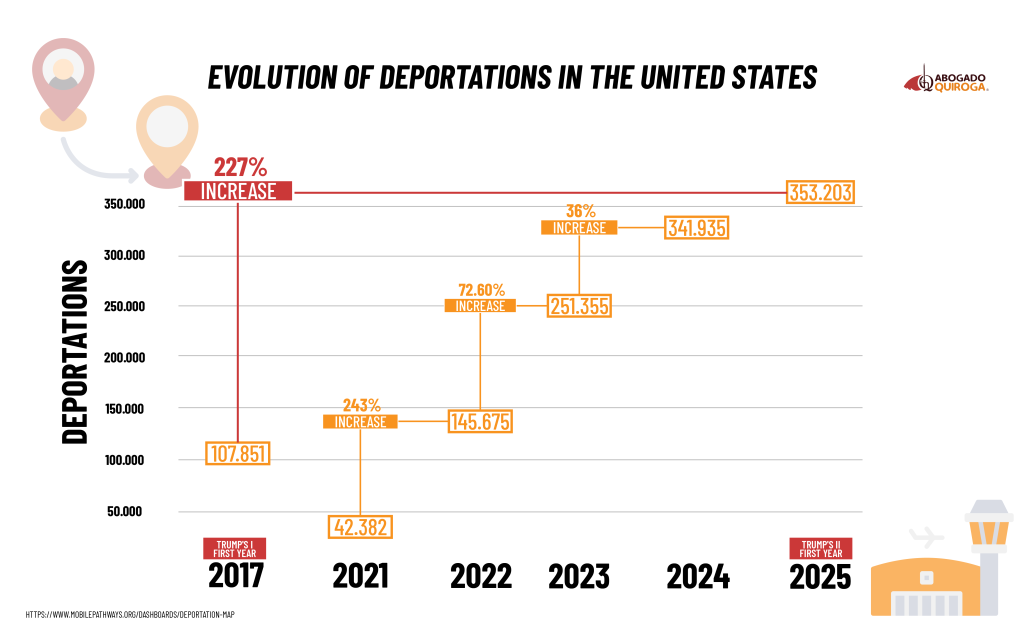
Where did most immigrants deported by the United States in 2025 come from?
According to Mobile Pathways, nine out of ten people expelled in 2025 were from Latin America, reflecting the regional nature of migration and the concentration of removal policies in the Global South. (https://www.mobilepathways.org/dashboards/deportation-map )
The removals carried out during fiscal year 2025 were mainly destined for countries on the American continent, that is, 84.4% (298,014) of the expulsions from United States to Latin American countries.
Detailed immigration court data on removal orders shows the top deportation destinations for FY 2025 were: Mexico (21.32%) 75,307 people , Honduras (14.08%) 49,717, Guatemala (13.61%) 48,079, Venezuela (8.33%) 29,416, Colombia (6.21%) 21,924, Nicaragua (5.81%) 20,522, Ecuador (5.33%) 18,835, El Salvador (4.77%) 16,853, Peru (2.78%) 9,810, Brazil (2.14%) 7,551 and Dominican Republic (1.51 %) 5.318.
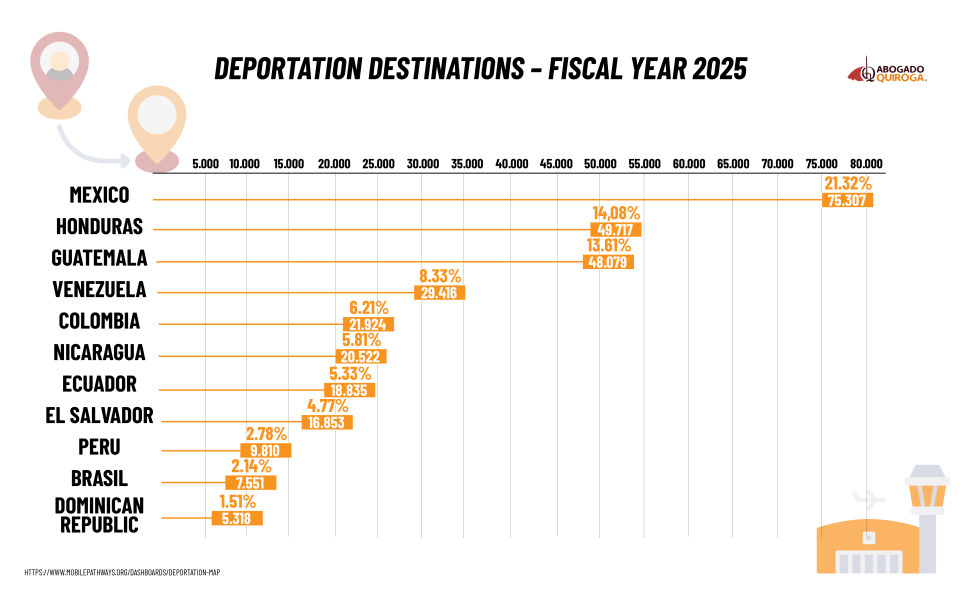
Arrests in immigration courts and asylum offices have driven up the numbers.
According to the Migration Policy Institute, authorities are approaching undocumented immigrants during their immigration court appearances or asylum interviews with USCIS. When the foreigner appears at these hearings, government attorneys have, in some cases, requested dismissal of the case, allowing immigrants to be subject to expedited deportation.
U.S. Immigration and Customs Enforcement (ICE) agents have stepped up operations in immigration courts. In cities like New York, Phoenix, Los Angeles, and Seattle, immigrants have been reported detained immediately after their immigration court hearings.
What’s happening with deportation cases in immigration court?
To answer this question, we analyzed data from Syracuse University’s TRAC, which showed that most deportees had a non-criminal profile, with fewer than 2% of new immigration court cases involving criminal activity. (https://tracreports.org/immigration/quickfacts/eoir.html )
As of August 2025, the Immigration Courts recorded 505,599 new cases. And according to court records, only 1.59% of these new cases in fiscal year 2025 requested deportation orders based on some alleged criminal activity of the immigrant.
In addition, as of August 2025, 495,198 deportation orders had been issued before the immigration court, a low figure compared to the 1,760,785 in 2024, 1,418,186 in 2023, and 791,034 in 2022, only surpassing the record of 317,268 of 2021. (https://tracreports.org/phptools/immigration/ntanew/)
The 2025 number is approximately 60.4 % higher than the 2017 figure, when Trump began his first administration and when 265,432 deportation cases were filed in immigration court.
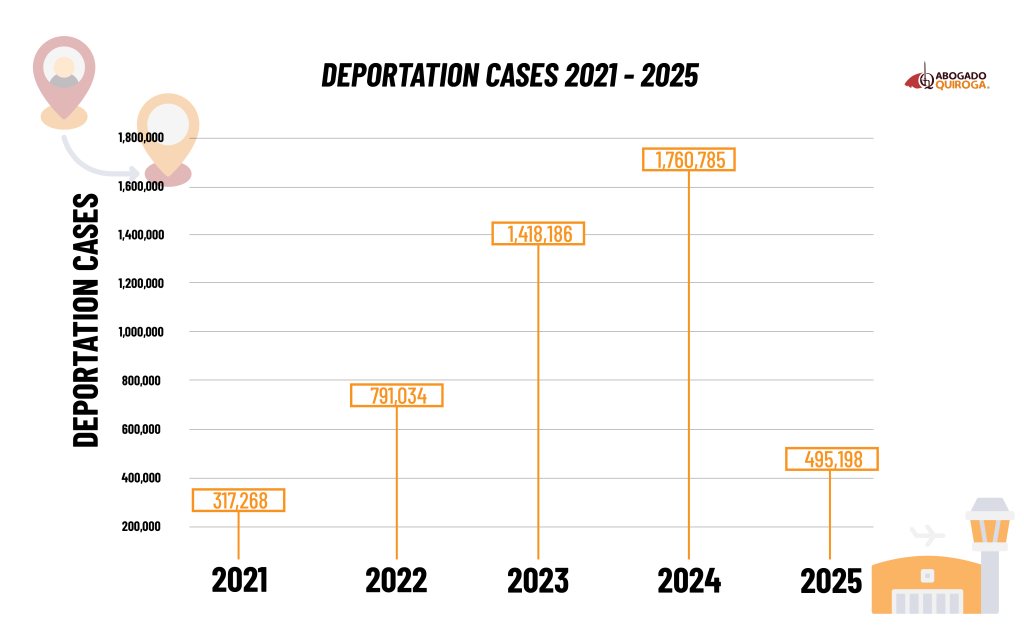
What will the state be in 2025?
The deportation landscape in the United States shows a significant concentration in a few states. Texas tops the list with 84,694 cases, consolidating its position as the epicenter of immigration removals in 2025. It is followed by Florida (67,499) and California (53,743), states with high immigrant populations and an active presence of ICE operatives. These three territories account for more than half of the total recorded among the top 10, reflecting a direct relationship between the size of their migrant communities, their policy of cooperation with federal authorities, and the number of deportation proceedings initiated or executed.
Further down the list are New York (34,504), Illinois (32,896), and New Jersey (30,295), areas traditionally considered «sanctuaries,» but where deportation orders remain high due to the high volume of cases in immigration courts. In contrast, southern and northeastern states such as Georgia, North Carolina, Arizona, and Massachusetts have lower numbers (between 10,000 and 20,000 cases). (https://tracreports.org/phptools/immigration/ntanew/ )
This allows us to observe how U.S. immigration policy continues to have a strong regional impact, with stricter enforcement in states with high immigrant arrival rates.
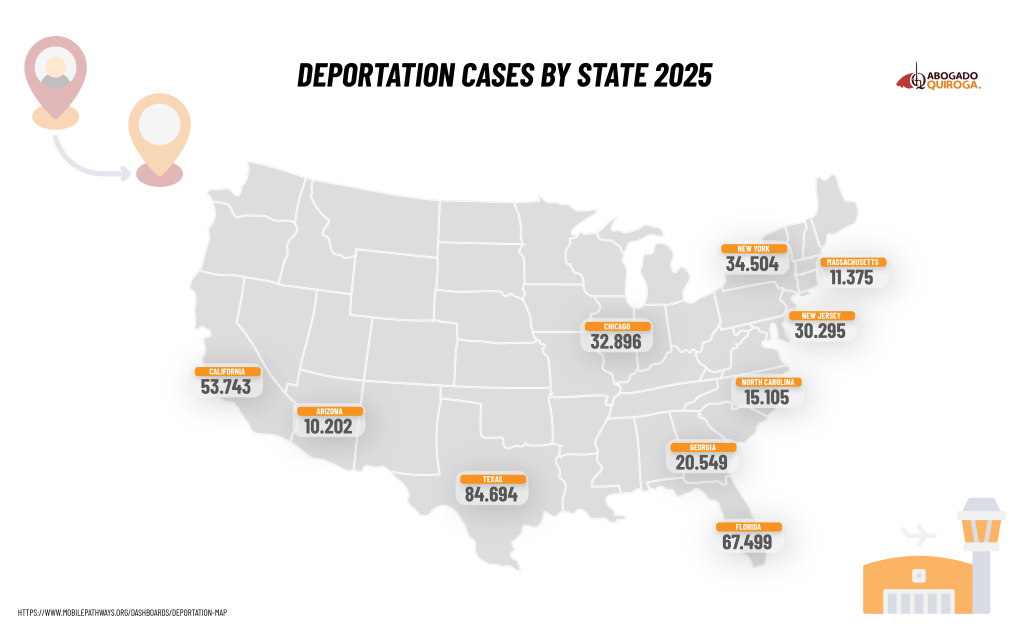
By charge, what do the deportation cases of the last 25 years reflect?
Over the past 25 years, deportation records in the United States reflect that most of the cases are linked to immigration violations rather than serious crimes. More than half of the removals (5.6 million cases, or 57.5%) correspond to people who entered without inspection, that is, without passing through an authorized port of entry or without being formally admitted by immigration authorities. Added to this group are another 3.5 million deportations (36.1%) stemming from other immigration charges, such as visa violations or unlawful stays. Adding these two types of charges together, they account for more than 93% of all deportations, confirming that the U.S. immigration system has historically prioritized expulsion for administrative reasons over criminal offenses.
In contrast, deportations for serious criminal offenses are lower. Only 406,946 cases (4.2%) correspond to «other criminal charges» and 185,877 (1.9%) to aggravated offenses, while those linked to accusations of terrorism or national security are virtually nonexistent, amounting to less than 0.1% of the total over a quarter of a century.
These figures refute the narrative that associates deportation primarily with criminality and show that the removal policy has been used primarily as an instrument of immigration control, mostly targeting those without legal status or who have committed administrative offenses.
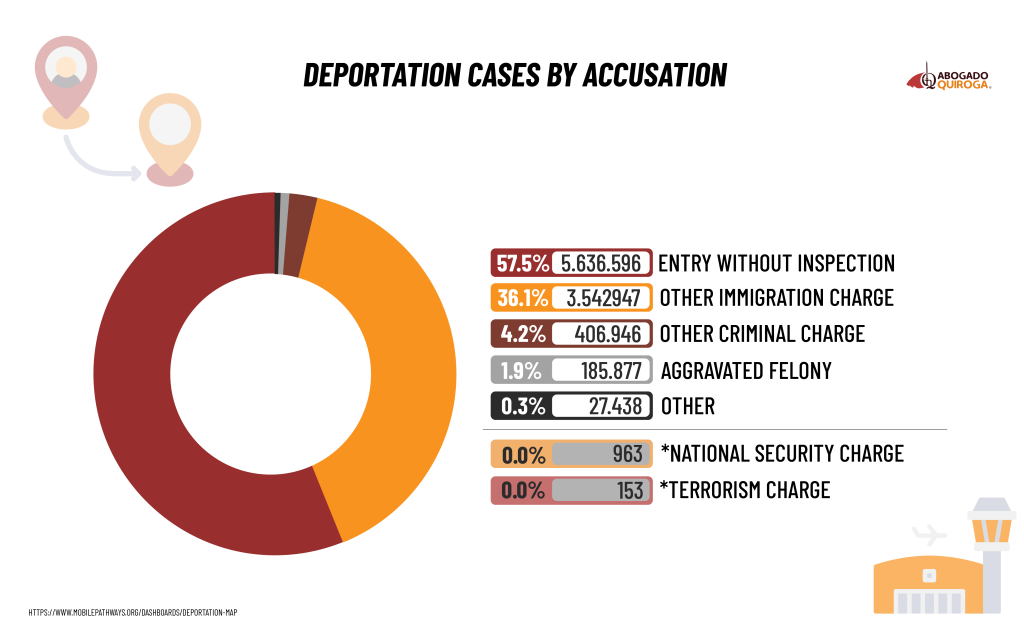
The American Immigration Council (AIC) also warned that the expansion of deportation policy has been accompanied by a “substantial reduction in due process” and access to legal representation, noting that only one in four people facing removal proceedings had an attorney in 2025. (https://www.americanimmigrationcouncil.org/wp-content/uploads/2025/07/mass_deportation_trump_attacks_democracy.pdf )
In short, the reports reviewed reveal a broader and more accelerated expulsion strategy, characterized by an increase in court orders, the intensity of ICE operations, and limited access to procedures for immigrants. The year 2025 has consolidated a policy of mass removals primarily in response to the government’s announced border control agenda, but which opens the debate on the legality and humanity of the U.S. immigration system.
